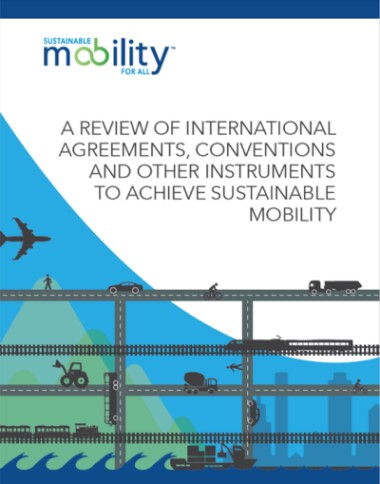
Sum4all launches a Review of International Agreements, Conventions and other Instruments to Achieve Sustainable Mobility
Summary of the Report
The Sustainable Mobility for All (SuM4All) initiative was born following a call for action from the President of the World Bank, Jim Yong Kim, at the Climate Action Summit 2016, which was welcomed by the United Nations (UN) Secretary General at the time, Ban Ki Moon. The call asked for accelerated efforts to implement the UN Sustainable Development Goals (SDGs) and transform the transport sector, through a new and unified strategic global initiative. The ECF is proud to call itself member of the SuM4All initiative.
SuM4All has recently launched a report reviewing current existing and applicable International Agreements, Conventions and Other Instruments to Achieve Sustainable Mobility. With the objective of assisting countries on the path towards achieving sustainable mobility goals, these instruments can be divided into the following categories: binding legal agreements and International Conventions, with standards and regulatory frameworks; nonbinding resolutions, statements, declarations, guidelines; and action programmes, with policy recommendations based on international knowledge and best practices.
Over 90 instruments have been identified and mapped across the four global goals, roughly half of which are legally binding.
LEGALLY BINDING INTERNATIONAL INSTRUMENTS
Under the umbrella of the United Nations (UN), there are numerous legal instruments referring to sustainable transport with a global or regional scope, administered by UN Regional Commissions and other UN agencies. In addition, the European Union (EU) develops its own legal instruments in the form of regulations and directives, which are binding for its Member States. The EU also focuses on a coordinated and effective deployment of Intelligent Transport Systems (ITS) as vital instruments to increase road safety and minimize carbon emission indexes and traffic congestion in Europe.
Regarding the safety global goal, there are several highly relevant internationally binding instruments tackling the issue of road safety. The UN Economic Commission for Europe (UNECE) administers seven core global UN Conventions on road safety and several other related legal instruments.
On the green mobility goal, international legal instruments work towards minimizing of the impact of transport on air quality, climate change, and the environment, as well as working to ensure the involvement of the public in the achievement of green mobility objectives. The green mobility goal is reflected in the Paris Climate Agreement under the UN Framework Convention on Climate Change (UNFCCC). This Agreement contains a combination of provisions that create binding legal obligations, as well as other provisions that create non-binding commitments. Amongst its many objectives, the Paris Agreement aims to achieve a “net zero emission economy” by 2050, to limit temperature increases over time, and to decarbonize the planet within the next 30-50 years.
There are also key binding international instruments that focus on gender equality and the right of women and girls to mobility and access to safe spaces. There are a large number of international policy Conventions and frameworks that pertain to the societal needs of women. The most well-known is the Universal Declaration of Human Rights. Mobility rights, or the right to travel, are considered an essential element of basic human rights. Another example is the UN Convention on the Elimination of all forms of Discrimination.
NONBINDING RESOLUTIONS, DECLARATIONS, AND STATEMENTS
The UN General Assembly (UNGA) has underscored the importance of transport efficiency by adopting three resolutions on sustainable mobility between 2014 and 2017. These resolutions call for more international cooperation, harmonization and improvement of transport and border-crossing infrastructure, facilities and services, and for stronger links between all modes of transport.
The UN Sustainable Development Goals (SDGs) identify important characteristics that define a sustainable world, including targets on the efficiency dimension of mobility. The EU develops and implements nonbinding policy recommendations, resolutions, and strategies for its member countries, with over 10 of those specifically addressing the issue of transport efficiency.
On the safety goal, the UNGA, active since 2003, has repeatedly addressed road injuries and fatalities. A total of 10 UNGA resolutions were adopted on improving global road safety. The 2011–2020 Decade of Action for Road Safety initiative was also a product of the UNGA global road safety resolutions, after which road safety improvement became part of the SDGs. Two SDG targets relate to road safety: halving the number of global deaths and injuries from road traffic accidents and improving road safety in cities.
The UN resolutions and the Decade of Action initiative have emphasized the importance of involving all stakeholders, including civil societies and the private sector, in the development of the road safety agenda. Transport safety is also addressed in document (iii), UN-Habitat, underlining the importance of protecting vulnerable road users, including pedestrians and bicyclists. For instance, with the development of its Roadmap to a Single European Transport Area, the EU aims to be an effective world leader in road safety and security with the introduction of several nonbinding instruments.
Green mobility and urban areas aim to curb the level of carbon emissions and implementing climate change mitigation interventions. Green mobility within many SDG targets, integrate climate change measures into national policies, strategies and planning addressing the impact of air pollution on health and cities. Transport therefore has a key role to play in achieving these goals. Other instruments include action plans, policies and tools, such as developed by the EU, for example, the 2016 EU Strategy on the Transition to Low-Emission Mobility, which focuses on multi-modality, transport mode shift, and technical innovations to reduce emissions.
There are also efforts to reduce emissions in cities, for example, the C40 Cities Climate Leadership Group has pledged to ensure zero emissions in large areas of their cities. In addition, the EU Commission has issued a series of proposals about green mobility: the “Europe on the Move - Mobility Package” which is a collection of three rounds of initiatives concerning the governance of road transport in the European Union: the first wave in June 2017 (8 proposals) has been complemented over the last 12 months by the second draft in November 2017 and the third one in May 2018. These proposals will, among other things, reduce CO2 emissions, improve air quality and public health by targeting improvements in transport.
ACTION PROGRAMMES AND RECOMMENDATIONS
In 2017, the United Nations Conference on Housing and Sustainable Urban Development (UN-Habitat) developed the New Urban Agenda (NUA), endorsed by the UNGA through resolution 66/207. The NUA represents the most significant effort to ensure that the urban population can benefit from economic and social opportunities through access to safe and good quality means of transport.
This text calls for action and recommends policies that involve attending to the needs of different groups—considering women, persons with disabilities, and vulnerable and marginalized people. The New Urban Agenda also stresses that policies applied to cities must help achieve the empowerment of women and girls. It provides a vision, principles, and tested practices for better and more sustainable cities worldwide. Its successful implementation is a critical step towards the realization of the 2030 Agenda for Sustainable Development, including the need to develop quality, reliable, sustainable, and resilient infrastructure, as well as safe and affordable measures. Though the Paris Agreement has a focus on green mobility, an analysis by UN-Habitat showed that the majority of Nationally Determined Contributions (NDCs) -113 of 164 - have a strong focus on moderating urban content, particularly in regions of Africa and Asia, clearly establishing an association between urbanization and climate change. The transport sector is the most referred to when it comes to urban climate action.
As a regional example, the Regional Action Programme developed by the United Nations Economic Commission for Asia and the Pacific (UNESCAP) for sustainable transport connectivity in Asia and the Pacific, phase I (2017-2021), indicates that countries and cities of the region must “initiate and implement innovative policies and frameworks to assess, plan, develop, improve and maintain sustainable urban transport systems and services.” This programme proposes guidelines, frameworks and studies as the specific outputs of this action plan.
The EU has adopted the Action Plan on Urban Mobility, with twenty measures to encourage and to help local, regional and national authorities in achieving sustainable urban mobility goals. Another instrument is the EU Declaration on cycling as a Climate Friendly Transport Mode, which aims at the integration of cycling as a multimodal transport policy.
The SuM4All report as a whole concludes that there are still some legislative gaps to work on at both the global and local levels: the UN legal instruments on these policies are not extensively known in every case, and thus accession to these instruments and implementation of the legislative agendas by States is not globally homogenized. Besides, implementation capacity is a key element that is also missing at the national and local government level, further complicating the adoption and implementation of international laws and recommendations on these policy agendas. In some cases, instruments on sustainably mobility are implemented only to a limited degree because of available government capacity, undermined good governance, or limited finances. In this case it becomes only limited to a specific region and not always available to all group of countries at a global level.
In conclusion, all these international instruments profiled in the SuM4All report show the efforts that the international community has, to move forward towards a sustainable mobility with legislative initiatives, recommendations and action plans. All these international conventions and policy recommendations are the valid frameworks to develop legal instruments that provide detailed regulations and standards to advance ahead and achieve the sustainable development goals.
Contact the author
Recent news!
Upcoming events
Contact Us
Avenue des Arts, 7-8
Postal address: Rue de la Charité, 22
1210 Brussels, Belgium










